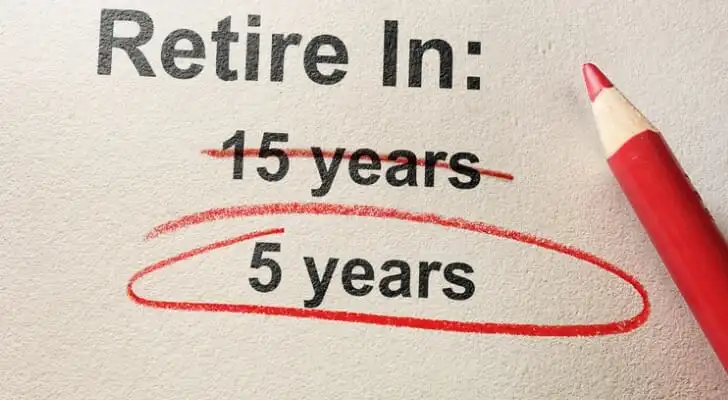Retiring early is a dream that many Americans have but most investors aren’t confident they an achieve that goal. While 65 is considered a normal or expected retirement age, we look at what types of investments and other factors to consider if you’re planning to retire by the age of 60.
A financial advisor can help you discover how to invest for retirement regardless of your target age with a plan that meets your individual goals.
Consider Your Current Investment Portfolio
One of the important pieces to the early retirement puzzle is your investment portfolio. Conventional wisdom is that, when you are young, you can take more risks with your investment choices since you have time to make up for any losses. Younger investors typically have a considerable proportion of common stock in their portfolios with lower amounts in less risky assets like bonds. There is a positive relationship between risk and return and you must take on more risk to have the potential to earn more from your investments.
As you get older, typically investors will decrease the amount of stock in their portfolios while increasing less risky investments like bonds or marketable securities. They may start investing with a portfolio that is 70 or even 80 percent in common stock and other risky investments and only 20 or 30 percent in conservative investments.
By the time they approach 60, many investors have used the 60/40 rule which is 60 percent of assets in riskier investments and 40 percent invested more conservatively. Traditionally, this mix has provided excellent diversification for investors with a decent amount of return. Achieving diversification depends on the skill with which you allocate your assets between investment classes.
Since the financial crisis in 2009 until December 2021, investors have found this 60/40 split to be a winner. Stocks have been in a long-running bull market bolstered by abnormally low-interest rates and low inflation. After December 2021, things changed. Due to market conditions, the 60/40 portfolio has been struggling and is down, across the board, by around 23 percent in 2022. There have only been two times historically that losses have topped 20%, both in the 1930s.
Keep Up With Financial Markets
Since December 2021, investors who want to retire at 60, as well as all investors, have had to rethink their asset allocation to avoid the 23% slide in returns on their portfolios if they were going the 60/40 route. Diversification and asset allocation in a portfolio have traditionally followed the market trend that the returns on stocks and bonds are negatively correlated.
Correlation refers to the degree to which stock and bond returns move in the same direction, or the opposite direction, to each other. The beauty of asset allocation and diversification is that, most often, stocks and bonds have moved in opposite directions. They have had a negative correlation. Gains from one asset class offset losses from the other.
Currently, due to high inflation and higher interest rates, stocks and bonds have a correlation of about 0.6 which is a positive correlation. Their returns are moving in the same direction, up or down. Correlation coefficients run from +1 to -1. A correlation of 1 means that the assets move perfectly with each other in the same direction. If it is -1, they move in the opposite direction.
It’s important to keep up with what’s happening in the financial markets so that you can adjust your portfolio accordingly. In order to retire early you need to continually improve your portfolio so that you don’t have to weather the downturns as long as many other investors.
Proper Asset Allocation
Asset allocation is an investment strategy that takes your individual investment goals, tolerance for risk and investment horizon into account. It helps you to put your money into the most profitable investments at a risk level you can tolerate for the time period that you have until retirement. After retirement, asset allocation is still a strategy you can use so your money will support you and last for the duration of your retirement.
As you age, you move to a more conservative asset allocation, but you still want to earn a decent return on your portfolio. You need some money in cash, but too much money in cash will cost you in return. If you want to invest in bonds, realize that the bond market is struggling, but short or intermediate-term high-grade bonds might be the solution.
Even though the stock market is down, it may be a buying opportunity if you have a time horizon of five or more years, and you do your research to try to find a quality, undervalued stocks. Increasing the proportion of stock in your portfolio is an alternative path. Another option is to check out equity-based real assets like natural resources which tend to return more during periods of high inflation. The 60/40 rule is not dead, but your portfolio may need some adjustments to navigate the current financial markets.
Potential Issues for Retiring at Age 60
If you want to retire at 60, you will not yet be able to receive Medicare to cover your health insurance needs. It will be necessary, in your retirement planning, to determine how you will handle your need for health insurance until the Medicare eligibility age. Health insurance can be a significant expense.
You will also not be eligible to start drawing your Social Security benefits at 60. You are eligible to draw partial benefits at 62, but since the benefit will never increase if you make this choice, you need to carefully consider your options. You need to be sure that the cash flow from your investments and other sources will cover your needs. You could work part-time after retirement or before you retire, and you can increase your savings to account for your needs.
The Bottom Line
Retiring early can seem very desirable after you have worked for many years. To have a comfortable retirement, you need to do a lot of advance planning concerning how much money you will save and invest and how to make your investments most profitable under circumstances in the financial markets. The U.S. had a long bull market when money was easier to make. You can still make money in less certain financial markets, but it takes knowledge and planning. You must consider several issues such as what kind of lifestyle you want after retirement, health insurance, taxes and more.
Tips for Early Retirement
- Many financial advisors have specialties in retirement planning and investing. To retire early, you will need to excel in these areas. You can also find a qualified financial advisor to assist you. SmartAsset’s free tool matches you with up to three financial advisors who serve your area, and you can interview your advisor matches at no cost to decide which one is right for you. If you’re ready to find an advisor who can help you achieve your financial goals, get started now.
- SmartAsset offers an asset allocation tool that helps you determine the amount of stock, bonds, cash or other assets for your investment portfolio.
Photo credit: ©iStock.com/marekuliasz, ©iStock.com/AscentXmedia, ©iStock.com/zimmytws


